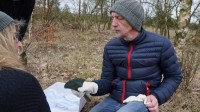 Just before Easter of this year, Christmas tree farmer Esben Arildskov asked a metal detecting friend Bent Rasmussen to survey a field on his farm in the village of Boest near Nørre Snede in Jutland, Denmark. Bronze artifacts had been found on the field before, and Arildskov wanted to be sure any historic artifacts were recovered before he cleared the area for planting. That responsible choice proved prescient. Rasmussen’s metal detector alerted to a large metal find and when he dug down, he found two large bronze axe heads. He immediately stopped digging and notified experts at the Museum Midtjylland of the find.
Just before Easter of this year, Christmas tree farmer Esben Arildskov asked a metal detecting friend Bent Rasmussen to survey a field on his farm in the village of Boest near Nørre Snede in Jutland, Denmark. Bronze artifacts had been found on the field before, and Arildskov wanted to be sure any historic artifacts were recovered before he cleared the area for planting. That responsible choice proved prescient. Rasmussen’s metal detector alerted to a large metal find and when he dug down, he found two large bronze axe heads. He immediately stopped digging and notified experts at the Museum Midtjylland of the find.
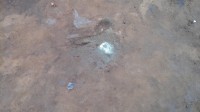 The two axes Rasmussen unearthed are 30 and 26 centimeters (one foot and 10 inches) long. The larger one weighs almost a full kilo (980 grams, 2.16 pounds); the smaller weighs 650 grams (1.4 pounds). Bronze Age axes are usually half this size, so the museum’s archaeologists were excited by the find. They examined the site and realized there was more to be found underneath the surface. They had to wait until after Easter to get started so on April 7th the official excavation began. Archaeologists, museum curators, journalists, neighbors and interested observers made the dig something of a party, complete with coffee and homemade cake. They had good cause to celebrate when three more oversized axes were unearthed. The axe hoard was painstakingly buried, each axe placed deliberately on top of the others inside a pit that was padded with grass.
The two axes Rasmussen unearthed are 30 and 26 centimeters (one foot and 10 inches) long. The larger one weighs almost a full kilo (980 grams, 2.16 pounds); the smaller weighs 650 grams (1.4 pounds). Bronze Age axes are usually half this size, so the museum’s archaeologists were excited by the find. They examined the site and realized there was more to be found underneath the surface. They had to wait until after Easter to get started so on April 7th the official excavation began. Archaeologists, museum curators, journalists, neighbors and interested observers made the dig something of a party, complete with coffee and homemade cake. They had good cause to celebrate when three more oversized axes were unearthed. The axe hoard was painstakingly buried, each axe placed deliberately on top of the others inside a pit that was padded with grass.
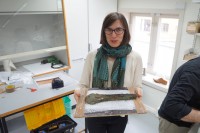 Radiocarbon dating found the axes were made between 1,800 and 1,500 B.C., a period bridging the end of the Stone Age and the beginning of the Bronze Age. This places them among the earliest bronze artifacts ever discovered in Denmark.
Radiocarbon dating found the axes were made between 1,800 and 1,500 B.C., a period bridging the end of the Stone Age and the beginning of the Bronze Age. This places them among the earliest bronze artifacts ever discovered in Denmark.
Bronze axes from this era are so rare only five of them have been found before in Denmark, Sweden and northern Germany. That means the Boest find has in one fell swoop doubled the number of these Bronze Age axes in the archaeological record of northern Europe. When you consider that
Bent Rasmussen and his brother, enlisted by Bent during excavations to cover more ground with their metal detectors, found another four smaller axes and a spear tip, it’s clear that this field in Boest was an important place during the early Bronze Age.
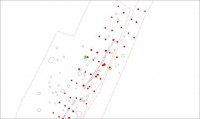 The would-be Christmas tree lot continued its archaeological hot streak when rows of large postholes were discovered. Four parallel rows of holes so large the posts they held would have been at least the height of a man. At first archaeologists thought they might be the remains of a dwelling or a fence, but as they kept excavating they kept finding more postholes. Ultimately they were able to follow an uninterrupted path of postholes for 109 meters before it disappeared into the forest. Now they’re thinking it may have been a processional route leading to burial mounds known to be on the property. This find is unique in Danish history, more akin to the pre-stone standing structures of Avebury and Stonehenge. Archaeologists hope to be able to excavate the entire processional in the near future, but first the funding has to be secured.
The would-be Christmas tree lot continued its archaeological hot streak when rows of large postholes were discovered. Four parallel rows of holes so large the posts they held would have been at least the height of a man. At first archaeologists thought they might be the remains of a dwelling or a fence, but as they kept excavating they kept finding more postholes. Ultimately they were able to follow an uninterrupted path of postholes for 109 meters before it disappeared into the forest. Now they’re thinking it may have been a processional route leading to burial mounds known to be on the property. This find is unique in Danish history, more akin to the pre-stone standing structures of Avebury and Stonehenge. Archaeologists hope to be able to excavate the entire processional in the near future, but first the funding has to be secured.
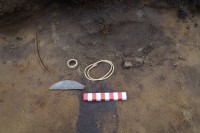 At the end of April, archaeologists unearthed another treasure across the post rows and slightly to the right of the axe hoard: two gold bracelets, one gold finger ring and two flint blades. The bangles weigh 21 grams (.74 ounces) apiece while the ring weighs a massive 16 grams (.56 oz). Modern wedding rings weigh a single gram, so this ring is exceptionally heavy. The gold deposit also dates to the transitional period between the Stone and Bronze Ages.
At the end of April, archaeologists unearthed another treasure across the post rows and slightly to the right of the axe hoard: two gold bracelets, one gold finger ring and two flint blades. The bangles weigh 21 grams (.74 ounces) apiece while the ring weighs a massive 16 grams (.56 oz). Modern wedding rings weigh a single gram, so this ring is exceptionally heavy. The gold deposit also dates to the transitional period between the Stone and Bronze Ages.
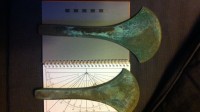 The axes are being conserved at the Museum Midtjylland after which they will be sent to the National Museum in Copenhagen for further analysis. Museum Midtjylland hopes the axes will be available for display this summer. Esben Arildskov has accepted that he won’t be planting Christmas trees on this land anytime soon, but he’s consoled by the fact that he’s the owner of a Bronze Age ceremonial center with huge axes and gold rings the weight of 16 regular rings buried hither and yon. He, his wife Birthe Rosvig and two daughters (aged five and eight) are thrilled to have found actual treasure in their back yard.
The axes are being conserved at the Museum Midtjylland after which they will be sent to the National Museum in Copenhagen for further analysis. Museum Midtjylland hopes the axes will be available for display this summer. Esben Arildskov has accepted that he won’t be planting Christmas trees on this land anytime soon, but he’s consoled by the fact that he’s the owner of a Bronze Age ceremonial center with huge axes and gold rings the weight of 16 regular rings buried hither and yon. He, his wife Birthe Rosvig and two daughters (aged five and eight) are thrilled to have found actual treasure in their back yard.